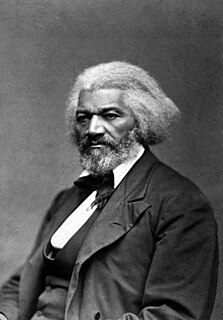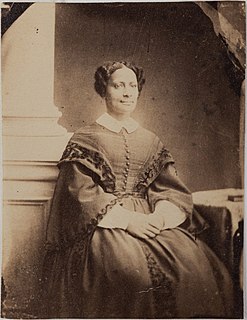
Frederick Douglass was an American social reformer, abolitionist, orator, writer, and statesman. After escaping from slavery in Maryland, he became a national leader of the abolitionist movement in Massachusetts and New York, becoming famous for his oratory and incisive antislavery writings. Accordingly, he was described by abolitionists in his time as a living counter-example to slaveholders' arguments that slaves lacked the intellectual capacity to function as independent American citizens. Likewise, Northerners at the time found it hard to believe that such a great orator had once been a slave.

Slavery and enslavement are the state and condition of being a slave, who is someone forbidden to quit their service for another person and is treated like property. Slavery relies heavily on the enslaved person being intimidated either by the threat of violence or some other method of abuse. In chattel slavery, the enslaved person is legally rendered the personal property (chattel) of the slave owner. In economics, the term de facto slavery describes the conditions of unfree labour and forced labour that most slaves endure. In the course of human history, slavery was often a feature of civilisation and legal in most societies, but is now outlawed in all countries of the world, except as punishment for crime.

Abolitionism, or the abolitionist movement, was the movement to end slavery. This term can be used both formally and informally. In Western Europe and the Americas, abolitionism was a historic movement that sought to end the Atlantic slave trade and set slaves free.

William Lloyd Garrison , who signed and printed his name Wm. Lloyd Garrison, was a prominent American abolitionist, journalist, suffragist, and social reformer. He is best known for his widely-read anti-slavery newspaper The Liberator, which he founded in 1831 and published in Boston until slavery in the United States was abolished by Constitutional amendment in 1865. He was one of the founders of the American Anti-Slavery Society, and promoted immediate and uncompensated, as opposed to gradual and compensated, emancipation of slaves in the United States.
"The source of Garrison's power was the Bible. From his earliest days, he read the Bible constantly and prayed constantly. It was with this fire that he started his conflagration. ...So also, a prejudice against all fixed forms of worship, against the authority of human government, against every binding of the spirit into conformity with human law, — all these things grew up in Garrison's mind out of his Bible reading."

Angelina Emily Grimké Weld was an American abolitionist, political activist, women's rights advocate, and supporter of the women's suffrage movement. She and her sister Sarah Moore Grimké are the only white Southern women who became abolitionists. The sisters lived together as adults, while Angelina was the wife of abolitionist leader Theodore Dwight Weld.

Anti-Slavery International, founded as the British and Foreign Anti-Slavery Society in 1839, is an international non-governmental organisation, registered charity and advocacy group, based in the United Kingdom. It is the world's oldest international human rights organisation, and works exclusively against slavery and related abuses.

The Liberator (1831–1865) was a weekly abolitionist newspaper, printed and published in Boston by William Lloyd Garrison and, through 1839, by Isaac Knapp. Religious rather than political, it appealed to the moral conscience of its readers, urging them to demand immediate freeing of the slaves ("immediatism"). It also promoted women's rights, an issue that split the American abolitionist movement. Despite its modest circulation of 3,000, it had prominent and influential readers, including Frederick Douglass and Beriah Green. It frequently printed or reprinted letters, reports, sermons, and news stories relating to American slavery, becoming a sort of community bulletin board for the new abolitionist movement that Garrison helped foster.

The Anti-Slavery Reporter was founded in London in 1825 as the Anti-Slavery Monthly Reporter by Zachary Macaulay (1768–1838), a Scottish philanthropist who devoted most of his life to the anti-slavery movement. It was also referred to as the British and Foreign Anti-Slavery Reporter, and in 1909 merged with the Aborigines' Friend to form the Anti-Slavery Reporter and Aborigines' Friend. From 1981 the journal was again renamed the Anti-Slavery Reporter, and as a publication of Anti-Slavery International continued to be published occasionally as simply Reporter.

Sarah Parker Remond was an American lecturer, activist and abolitionist campaigner. Born a free woman in the state of Massachusetts, she became an international activist for human rights and women's suffrage. Remond made her first public speech against the institution of slavery when she was 16 years old, and delivered abolitionist speeches throughout the northeastern United States. One of her brothers, Charles Lenox Remond, became known as an orator and they occasionally toured together for their abolitionist lectures.

The National Anti-Slavery Standard was the official weekly newspaper of the American Anti-Slavery Society, established in 1840 under the editorship of Lydia Maria Child and David Lee Child. The paper published continuously until the ratification of the Fifteenth Amendment to the United States Constitution in 1870. Its motto was "Without Concealment—Without Compromise." It not only implies suffrage rights for colored males, but also women's suffrage as well. It contained Volume I, number 1, June 11, 1840 through volume XXX, number 50, April 16, 1870.

Slavery has been called "deeply rooted" in the structure of the northwestern African country of Mauritania, and "closely tied" to the ethnic composition of the country.

Slavery has historically been widespread in Africa. Systems of servitude and slavery were common in parts of Africa in ancient times, as they were in much of the rest of the ancient world. When the Arab slave trade and Atlantic slave trade began, many of the pre-existing local African slave systems began supplying captives for slave markets outside Africa.

The abolition of slavery occurred at different times in different countries. It frequently occurred sequentially in more than one stage – for example, as abolition of the trade in slaves in a specific country, and then as abolition of slavery throughout empires. Each step was usually the result of a separate law or action. This timeline shows abolition laws or actions listed chronologically. It also covers the abolition of serfdom.

The continent of Africa is one of the regions most rife with contemporary slavery. Slavery in Africa has a long history, within Africa since before historical records, but intensifying with the Arab slave trade and again with the trans-Atlantic slave trade; the demand for slaves created an entire series of kingdoms which existed in a state of perpetual warfare in order to generate the prisoners of war necessary for the lucrative export of slaves. These patterns have persisted into the colonial period during the late 19th and early 20th century. Although the colonial authorities attempted to suppress slavery from about 1900, this had very limited success, and after decolonization, slavery continues in many parts of Africa despite being technically illegal.
The Aborigines' Protection Society (APS) was an international human rights organisation founded in 1837, to ensure the health and well-being and the sovereign, legal and religious rights of the indigenous peoples while also promoting the civilisation of the indigenous people who were subjected under colonial powers, in particular the British Empire. In 1909 it merged with the British and Foreign Anti-Slavery Society (BFASS) to form the Anti-Slavery and Aborigines' Protection Society.

Human trafficking is the trade of humans for the purpose of forced labour, sexual slavery, or commercial sexual exploitation for the trafficker or others. This may encompass providing a spouse in the context of forced marriage, or the extraction of organs or tissues, including for surrogacy and ova removal. Human trafficking can occur within a country or trans-nationally. Human trafficking is a crime against the person because of the violation of the victim's rights of movement through coercion and because of their commercial exploitation. Human trafficking is the trade in people, especially women and children, and does not necessarily involve the movement of the person from one place to another.

Lucretia Mott was a U.S. Quaker, abolitionist, women's rights activist, and social reformer. She had formed the idea of reforming the position of women in society when she was amongst the women excluded from the World Anti-Slavery Convention in 1840. In 1848 she was invited by Jane Hunt to a meeting that led to the first meeting about women's rights. Mott helped write the Declaration of Sentiments during the 1848 Seneca Falls Convention.

The World Anti-Slavery Convention met for the first time at Exeter Hall in London, on 12–23 June 1840. It was organized by the British and Foreign Anti-Slavery Society, largely on the initiative of the English Quaker Joseph Sturge. The exclusion of women from the convention gave a great impetus to the women's suffrage movement in the United States.

Abolitionism in the United States was the movement that sought to end slavery in the United States, and was active both before and during the American Civil War. In the Americas and Western Europe, abolitionism was a movement that sought to end the Atlantic slave trade and to free the slaves. In the 18th century, Enlightenment thinkers condemned slavery on humanistic grounds, and English Quakers and some Evangelical denominations condemned slavery as un-Christian. At that time, most slaves were Africans or descendants of Africans, but thousands of Native Americans were also enslaved. In the 18th century, as many as six million Africans were transported to the Americas as slaves, at least a third of them on British ships to North America. The Colony of Georgia originally prohibited slavery.
The Ohio Women's Convention at Salem in 1850 met on April 19–20, 1850 in Salem, Ohio, a center for reform activity. It was the third in a series of women's rights conventions that began with the Seneca Falls Convention of 1848. It was the first of these conventions to be organized on a statewide basis. About five hundred people attended. All of the convention's officers were women. Men were not allowed to vote, sit on the platform or speak during the convention. The convention sent a memorial to the convention that was preparing a new Ohio state constitution, asking it to provide for women's right to vote.














